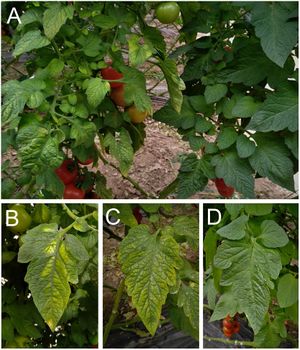Tomato chlorosis virus
| Literature database |
|---|
| 140 articles sorted by: |
| • year (descending) |
| • research topics |
| • countries/regions |
| • host plants |

Authors: Elvira Fiallo‐Olivé and Jesús Navas‐Castillo
Source: Molecular Plant Pathology (2019), 20 (9), p. 1308
Tomato chlorosis virus (ToCV)
This virus is widely distributed. It has been originally described from North America in 1996, but has since been reported from various countries of the Americas, Europe, Africa and Asia. Ii is a phloem-limited, bipartite crinivirus which infects tomato and some other crops and can cause economic losses. The symptoms depend on the host plant and include yellowing, leaf curling, reddening and necrosis. A bright yellow interveinal chlorosis might develop, starting with the lower leaves, while the veins remain green. Fruits show a significant reduction in size and yield, but remain symptomless. The virus is transmitted by various whitefly species in a semi-persistent manner, e.g. Trialeurodes vaporariorum, Trialeurodes abutilonea, and Bemisia tabaci.
The particles are filamentous with a length of about 850 nm. The genome has the typical organization of bipartite criniviruses, with two molecules of linear, positive-sense, single-stranded RNA, namely RNA1 (8593–8596 nt) and RNA2 (8242–8247 nt). RNA1 has 4 open reading frames, encoding proteins which seem to be associated with virus replication and the suppression of gene silencing. RNA2 contains nine ORFs (ORF4 to ORF12), possibly encoding proteins involved in virus encapsidation, cell-to-cell movement, membrane association, whitefly transmission and the suppression of gene silencing. Both RNAs are encapsidated in separated particles, but are both needed for infection. See also the related Tomato infectious chlorosis virus.
For a review of this virus see Fiallo-Olivé & Navas-Castillo, 2019.